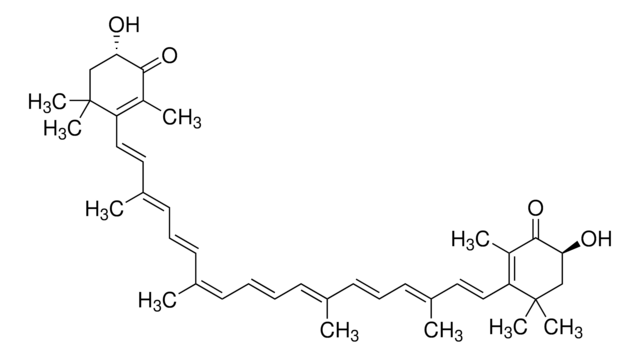推荐产品
等級
analytical standard
品質等級
化驗
≥97%
儲存期限
limited shelf life, expiry date on the label
技術
HPLC: suitable
gas chromatography (GC): suitable
應用
cleaning products
cosmetics
food and beverages
personal care
格式
neat
儲存溫度
−20°C
SMILES 字串
CC1=C(/C=C/C(C)=C/C=C/C(C)=C/C=C/C=C(C)/C=C/C=C(C)/C=C/C2=C(C)C([C@@H](O)CC2(C)C)=O)C(C)(C)C[C@H](O)C1=O
InChI
1S/C40H52O4/c1-27(17-13-19-29(3)21-23-33-31(5)37(43)35(41)25-39(33,7)8)15-11-12-16-28(2)18-14-20-30(4)22-24-34-32(6)38(44)36(42)26-40(34,9)10/h11-24,35-36,41-42H,25-26H2,1-10H3/b12-11+,17-13+,18-14+,23-21+,24-22+,27-15+,28-16+,29-19+,30-20+/t35-,36-/m0/s1
InChI 密鑰
MQZIGYBFDRPAKN-UWFIBFSHSA-N
正在寻找类似产品? 访问 产品对比指南
相关类别
一般說明
全-反式-虾青素属于类胡萝卜素。全反式虾青素是酮式类胡萝卜素,常见于海洋和水生动物,包括磷虾、野生鲑鱼、虹鳟鱼、微藻、龙虾壳、虾、 海产品等。 在生物学上将其称为维生素A 前体,具有强大的抗氧化性能,抗氧化能力比维生素E和 β-胡萝卜素大得多。 它在食品行业和医药行业的作用也十分明确。
應用
全反式虾青素可作为分析参考标准品,用于:
- 使用高效液相色谱(HPLC)结合质谱 和荧光检测(HPLC-FLD),定量微藻(绿藻)和雨生红球藻( Haematococcus pluvialis )中的分析物。
- 使用高效液相色谱(HPLC)和光电二极管阵列检测(PDA)定量哈氏仿对虾(Parapenaeopsis hardwickii )中的分析物。
有关合适的仪器技术的更多信息,请参阅产品′的分析证书。想要获得更多支持,请联系技术服务部。
生化/生理作用
虾青素是在海藻、红酵母和许多植物和动物来源中发现的强效类胡萝卜素抗氧化剂。动物试验表明,它可降低血糖并改善糖尿病代谢综合征的若干指标。可改善高血型模型的血流和血管张力。体外研究表明,它上调间隙联接蛋白 43,可用于化学防癌。
包裝
无底玻璃瓶。内含物装在插入的融合锥内。
儲存類別代碼
11 - Combustible Solids
水污染物質分類(WGK)
WGK 3
閃點(°F)
Not applicable
閃點(°C)
Not applicable
個人防護裝備
Eyeshields, Gloves, type N95 (US)
其他客户在看
Characterisation of esterified secondary carotenoids and of their isomers in green algae: a HPLC approach
Remias D and Lutz C
Algological Studies, 124(1), 85-94 (2007)
Dieudonné M Dansou et al.
Poultry science, 100(9), 101304-101304 (2021-08-04)
Long-term and graded dose of astaxanthin supplementation in laying hen's diet was assessed for egg fortification. Five groups of laying hens with 8 replications each were fed for 24 wk with diet supplemented astaxanthin at 0 mg/kg (control), 7.1 mg/kg
Chromatographic separation and purification of trans-astaxanthin from the extracts of Haematococcus pluvialis
Yuan P-J and Chen F
Journal of Agricultural and Food Chemistry, 46(8), 3371-3375 (1998)
Jian-Ping Yuan et al.
Molecular nutrition & food research, 55(1), 150-165 (2011-01-06)
The ketocarotenoid astaxanthin can be found in the microalgae Haematococcus pluvialis, Chlorella zofingiensis, and Chlorococcum sp., and the red yeast Phaffia rhodozyma. The microalga H. pluvialis has the highest capacity to accumulate astaxanthin up to 4-5% of cell dry weight.
Martin Guerin et al.
Trends in biotechnology, 21(5), 210-216 (2003-05-03)
The carotenoid pigment astaxanthin has important applications in the nutraceutical, cosmetics, food and feed industries. Haematococcus pluvialis is the richest source of natural astaxanthin and is now cultivated at industrial scale. Astaxanthin is a strong coloring agent and a potent
我们的科学家团队拥有各种研究领域经验,包括生命科学、材料科学、化学合成、色谱、分析及许多其他领域.
联系技术服务部门












